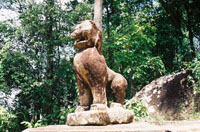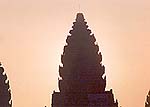


Section 4: Antiquities - Capitalism and Spiritualism
If ever there was an urgency to get Preah Vihear on the World Heritage listing it is now before every artistic example from this sacred site is lost forever for humanity to experience. It is very unfortunate that Cambodia and Thailand have taken so long to bridge their distrust for one another on who could claim managing seniority of Preah Vihear. Those attitudes of distrust have allowed one of the most sacred temples on earth to be robbed of its art work so that no longer can people of this planet experience the past glory of this Shivaite sanctuary created between the 9th and 16th century. The desolation that has befallen Preah Vihear is dispicable and needs to be rectified. Hopefully we can believe the foriegn minister Surakiart Sathirathai of Thailand and Sok An senior minister in charge of the council of ministers in Cambodia that their joint development agreement reached on March 25, 2004 will be initiated. The two countries have agreed to restore the hilltop sanctuary to preserve its beauty and artistic, historical and archaeological values. I would add whats left of Preah Vihear needs to be preserved and recognized for how serious its deterioration really is and not gloss over the fact that indecision has done more to harm the temple than good. The two ministers claim the restoration program will be conducted with UNESCO after it accepts a proposal to list Preah Vihear Temple as a World Heritage site
For now, however, all the bright blue highway tourist signs leading to Preah Vihear indicating a sanctuary should be honored, and all the vendors should be told to leave the sacred grounds so humanity can experience the wedding of heaven and earth on this mountain abode dedicated to the gods without being accosted by hawkers. The solemnity and sacredness which are expected from a sanctuary are sadly missing from this Khmer temple. In my opinion it is an outright sacrilege to have to listen to mechanical birds and musical games while trying to meditate at Preah Vihear. There should be absolutely no hesitation to give Preah Vihear the distinction of a World Heritage site.
Wat Phu in Champassak S. Laos was made a World Heritage site in December 2002 thanks to the efforts of Thongsa Sayavongkhamdy, Director of the Development of Museums and Archaeology Ministry of Information and Culture in Vientiane, Laos. The Japanese government has even provided special funding for a museum at Wat Phu for displaying recent artifacts found around the temple grounds. Now Wat Phu is protected and respected as the 1st Khmer holy temple also known as Bhadresvara, constructed in the early 4th and 5th centuries and perhaps much earlier.
Phreah Vihear has been well researched by the EFEO, Ecole Francaise Extreme Orient, and an exhaustive compialation of all research from the late 19th century and even including the beginning of the 20th century was done by Lawrence Palmer Briggs in his work "The Ancient Khmer Empire". Briggs gives ample historical facts to the significance of Preah Vihear during the Khmer Empire's reign which should quell any commentary suggesting that there is not enough information about Preah Vihear to merit a World Heritage site listing. Most recently Charles Higham from New Zealand and his detalied work titled, "The Civilization of Angkor" gives important insights to the miracles which took place at Preah Vihear, and how all the sacred palm-leaf documents were kept by the keeper of the archives, Sukavarman, under King Suryavarman I. No single text, however, is as beautiful as Dhida Saraya's "Preah Vihear, Sri Sikharesvara". Inside this beautifully bound book are details of inscriptions, photographs, and history all combined to give a very compelling portrait of this sacred temple. Surely there should be no doubt on the historical accuracy of Preah Vihear. It is simply untrue that there is not sufficient research on Preah Vihear as some authorities claim.
So why is it taking Cambodia so long to get Preah Vihear a World Heritage site listing? Almost every single lion statue has been removed from the staircase, and only a few exist as sentinels to this holy temple. The lotus columns along the causeways have all but disappeared, and the lintels are badly damanged, removed, sunk in the ground, covered by weeds, or can be seen sticking out of the grass.
 |
 |
 |
 |
Many of Pol Pot's (Solarth Sar) cadres retreated to Preah Vihear in 1975 and it wasn't until 1998 that the mountain temple was re-opened to the public. The years between 1975-1998 were probably the most devastating years of pillage and destruction Preah Vihear has ever known.
In February of 2004 the International Conclave of Buddhism and Tourism was held in New Delhi, India. One of the issues addressed was why are spiritual sites attracting so many "spiritual tourists"? Without an understanding of the negative side effects of the countless thousands of people journeying to sacred sites will most assuredly make "spirital tourism" become another devastating influence beyond even pillaging and destruction. This issue of growing numbers of "spiritual tourists" has been made sadly obvious with the sacred temple in Borobudur in Indonesia. There has been a constant stream of articles being written by Yogyakarta of Indonesia for Reuters News Services stating that, "Borobudur is besieged by commerce and is in danger of being completely commercialized".
When Preah Vihear becomes a World Heritage site are the hotels going to start booming on the Thai border as they did in Siem Reap, Cambodia for Angkor Wat? The casinos have already begun encroaching the Cambodian border, and a resort is even being built over the grave site of Pol Pot by Cambodian investors. The Supreme Patriarch of Cambodia H.H. Samdech Tep Vong needs to assert his conviction for the protection of the sanctity of Preah Vihear, and to dictate to Ang Su, the Senior Minister of Cambodia, to enforce the effort to curb looting that is plaguing not only Preah Vihear but all the Khmer temples in Cambodia. There will be no sanctity left in the 21st century for pilgrimages to Cambodia as H.H. Sandech Tep Vong suggests unless this issue of "spiritual tourism" is seen for what it truly is; a way to make more money at the expense of the spiritual spaces which all sacred temples occupy.
Dougland O'Reilly director of Heritage Watch in Phnom Penh has created the 1st independent group of its kind in Cambodia and has joined with archaeologists from around the world aimed at preventing looters from spiriting away Cambodia's ancient treasurers. All countries need to impose an "Emergency Import Restriction on Khmer Stone Archaeological Material Dating from the 6th Century through the 16th Century" to protect any further devastation to these temples. But again, the Asian Art Market like its sister's commercial organization, "spiritual tourism", competes with efforts to maintain spiritual integrity. Masayuki Nagashima's work, "The Lost Heritage", The Reality of Artifact smuggling in Southeast Asia, is the best insight into this deplorable antiquities market.
Whatever beliefs we may harbor about divinity and spiritualism in the beginning of the 21st century they are certainly not the same devotional beliefs of the once great Devaraja cult that the Brahmins brought to Cambodia over 2,500 years ago. Lord Shiva, Vishnu and Brahma originated from the heavens on Mt. Meru. The Khmer Kings then used the mountains and hilltop abodes to honor their ancestors and dieties. If modern man wishes to experience these abodes with the same respect shown to them in ages long gone then market economics can not be the driving force to protect the temples. Instead preservation of our spiritual history should be the driving force for saving the temples rather than how much money can be made from patronizing them.
Only in the last 100 years has there begun to be an understanding of the majesty of the Khmer Empire and only in the last 50 years, I venture to say, has there been more damage and destruction inflicted on these temples than at any time in the ancient past.
 Section 1: Piligrimage - Getting there
Section 1: Piligrimage - Getting there
 Section 2: Arrival - Photo Galleries
Section 2: Arrival - Photo Galleries
 Section 3: Bhavalai - Another time
Section 3: Bhavalai - Another time
 Section 5: Politics - Kings to Commoners
Section 5: Politics - Kings to Commoners
 "Preah Vihear: An Introdiction to the World Heritage Monument" by Sachchidanand Sahai
"Preah Vihear: An Introdiction to the World Heritage Monument" by Sachchidanand Sahai
Other stories related to the Khmer Empire.
 |
|  |
| 
Part I- Stones in the Sky - Before the Journey to Angkor Wat
Part II - Stones in the Sky - Journey to Angkor Wat - July 2002.
Part III - Stones in the Sky - Section I - Journey to Angkor Wat - March 2003.
Part III - Stones in the Sky - Section II - Journey to Angkor Wat - March 2003.
Part V - Stones in the Sky - Journey to Beng Mealea - October 2004.
Apsaras and Devatas - Photo documentation of female divinities at Angkor Wat.
Related links:
Heritage Watch - Dr. Doug O'Reilly, Director
History of Science, Vedic Studies, Astronomy - By Subhash Kak